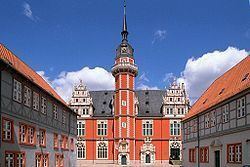Country Germany District Helmstedt Elevation 123 m (404 ft) Population 24,402 (31 Dec 2008) Postal code 38350 | First mentioned 952 Time zone CET/CEST (UTC+1/+2) Local time Thursday 11:35 AM University University of Helmstedt | |
 | ||
Weather 8°C, Wind SW at 14 km/h, 73% Humidity | ||
Helmstedt ( [ˈhɛlmˌʃtɛt]) is a town on the eastern edge of the German state of Lower Saxony. It is the capital of the District of Helmstedt. The historic university and Hanseatic city conserves an important monumental heritage of Romanesque and Renaissance buildings, as well as numerous timber framed houses. During the German partition the nearby Bundesautobahn 2 was the site of the Helmstedt–Marienborn border crossing, the most important on the former inner German border as starting point of the shortest land route between West Germany and West Berlin.
Contents
Map of 38350 Helmstedt, Germany
Geography
Helmstedt is situated in a basin between the Elm and Lappwald hill ranges, at the transition area between the northern foothills of the Harz mountains and the North German Plain. It is surrounded by the Elm-Lappwald Nature Park. The town centre is located about 36 kilometres (22 mi) east of Braunschweig, 45 kilometres (28 mi) west of Magdeburg, and 90 kilometres (56 mi) east of the state capital Hanover.
The municipal area includes the localities of Barmke and Emmerstedt, both incorporated by a 1974 administrative reform, as well as the resort town of Bad Helmstedt, about 3.5 kilometres (2.2 mi) east of the town centre. Helmstedt currently has about 23,000 inhabitants (2013).
History
The settlement in the Duchy of Saxony was first mentioned as Helmonstede in a 952 deed issued by the German king Otto I. In former times also called Helmstädt, the town developed in the vicinity of the Benedictine St. Ludger's Abbey that was founded around 800 by Saint Liudger as a mission station. Helmstedt's town privileges were documented in 1247. It belonged to the Abbacy of Werden until 1490, when it was bought by the Duchy of Brunswick-Lüneburg. From 1576 to 1810, the University of Helmstedt was located here.
From the late 1940s to 1990, the town was the site of a major border crossing between the Federal Republic of Germany and the German Democratic Republic. The main rail and autobahn route between West Germany and Berlin, across the GDR, began at the Helmstedt–Marienborn border crossing, also known as Checkpoint Alpha. Official military traffic from NATO countries to West Berlin was only allowed to use this route.
Famous citizens
In addition, see the list of famous students and professors of the University of Helmstedt.
